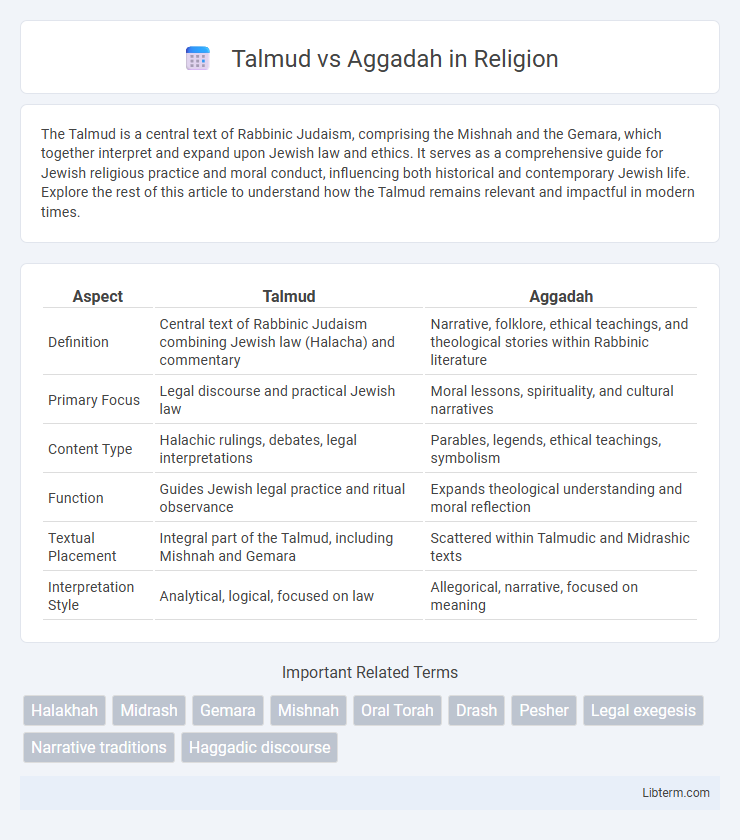The Talmud is a central text of Rabbinic Judaism, comprising the Mishnah and the Gemara, which together interpret and expand upon Jewish law and ethics. It serves as a comprehensive guide for Jewish religious practice and moral conduct, influencing both historical and contemporary Jewish life. Explore the rest of this article to understand how the Talmud remains relevant and impactful in modern times.
Table of Comparison
| Aspect | Talmud | Aggadah |
|---|---|---|
| Definition | Central text of Rabbinic Judaism combining Jewish law (Halacha) and commentary | Narrative, folklore, ethical teachings, and theological stories within Rabbinic literature |
| Primary Focus | Legal discourse and practical Jewish law | Moral lessons, spirituality, and cultural narratives |
| Content Type | Halachic rulings, debates, legal interpretations | Parables, legends, ethical teachings, symbolism |
| Function | Guides Jewish legal practice and ritual observance | Expands theological understanding and moral reflection |
| Textual Placement | Integral part of the Talmud, including Mishnah and Gemara | Scattered within Talmudic and Midrashic texts |
| Interpretation Style | Analytical, logical, focused on law | Allegorical, narrative, focused on meaning |
Introduction to Talmud and Aggadah
The Talmud, a central text of Rabbinic Judaism, comprises the Mishnah and the Gemara, offering a comprehensive legal and ethical framework through detailed discussions of Jewish law (Halacha). Aggadah refers to the non-legalistic narratives, folklore, theological insights, and moral teachings interspersed throughout the Talmud, providing cultural and spiritual context. Understanding the distinction between Talmudic legal debates and Aggadic storytelling is essential for grasping the multifaceted nature of Jewish tradition and scriptural interpretation.
Defining the Talmud: Structure and Purpose
The Talmud, composed of the Mishnah and Gemara, serves as the central text of Rabbinic Judaism, providing extensive legal analysis and commentary on Jewish law. Its structure intertwines halakhic discussions with narrative elements, distinguishing strictly legal content from broader ethical and philosophical teachings found in Aggadah. This dual purpose establishes the Talmud as both a legal code and a repository of cultural and theological insights.
Understanding Aggadah: Meaning and Scope
Aggadah encompasses the narrative, ethical teachings, and folklore within the Talmud, providing cultural and moral insights beyond legal discussions. It serves as a vehicle for expressing Jewish values, theology, and historical context, often contrasting with the Halakhic focus on law and jurisprudence. Understanding Aggadah requires recognizing it as a diverse collection that enriches the Talmud with interpretive stories and philosophical reflections.
Historical Origins of Talmud and Aggadah
The Talmud, developed between the 3rd and 5th centuries CE in Babylon and Palestine, represents a comprehensive compilation of Jewish oral law and rabbinic discussions. Aggadah, embedded within the Talmud and Midrashim, comprises narrative, ethical teachings, and folklore that complement the legalistic content. Historically, the Talmud emerged from the Mishnah's codification, while Aggadah evolved to provide cultural, theological, and moral insights shaping Jewish thought and tradition.
Legal vs. Non-Legal Texts: Halakhah and Aggadah
The Talmud encompasses both Halakhah and Aggadah, where Halakhah represents the legal texts that govern Jewish law and practice, while Aggadah comprises non-legal narratives, ethical teachings, and theological reflections. Halakhah provides detailed jurisprudence and commandments essential for religious observance, contrasting with Aggadah's focus on storytelling, moral lessons, and spiritual insights. This distinction highlights the dual nature of the Talmud in balancing legal rigor with cultural and ethical wisdom.
Literary Styles: Analysis and Comparison
The Talmud employs a rigorous dialectical style, characterized by complex legal discussions (Halakhah) with precise argumentative structures and detailed case analyses. In contrast, Aggadah showcases a more narrative and poetic literary style, utilizing parables, folklore, and moral teachings to convey ethical and theological themes. This contrast highlights the Talmud's focus on legal reasoning and the Aggadah's emphasis on storytelling and imaginative expression within Jewish classical literature.
Theological Themes in Talmud and Aggadah
Theological themes in the Talmud emphasize legal discourse, ethical conduct, and interpretations of Jewish law, providing a framework for religious practice and communal norms. In contrast, Aggadah explores narratives, ethical teachings, and mystical insights, enriching theological understanding through stories and allegories that convey moral and spiritual lessons. Both texts interweave to shape Jewish thought, with the Talmud offering structured jurisprudence and Aggadah presenting expansive theological reflections.
Interpretative Methods and Approaches
Talmud employs rigorous analytical methods and dialectical reasoning to derive legal rulings and clarify Jewish law, relying heavily on logical argumentation and textual comparisons. Aggadah, in contrast, embraces a more narrative and interpretive approach, using storytelling, allegory, and ethical teachings to convey moral lessons and spiritual insights. These differing methodologies reflect the Talmud's focus on halakhic precision and Aggadah's emphasis on cultural and theological expression within Jewish tradition.
Influence on Jewish Thought and Practice
The Talmud, comprising the Mishnah and Gemara, serves as the foundational text for Jewish legal principles, deeply influencing Halakhic rulings and daily religious observance. Aggadah, embedded within the Talmud and other rabbinic literature, enriches Jewish thought through narrative, ethical teachings, and mystical insights, shaping moral values and cultural identity. Together, Talmudic law and Aggadic storytelling continuously guide interpretive traditions and communal practices within Judaism.
Modern Relevance and Continuing Debates
Talmud and Aggadah remain central to contemporary Jewish thought and legal practice, with Talmud providing the foundation for Halakhic decision-making while Aggadah offers ethical and philosophical insights that resonate in modern discourse. Scholars and religious communities continue debating the interpretation and application of Halakhic rulings from Talmudic texts versus the narrative and moral lessons embedded in Aggadic passages. The evolving engagement with these sources shapes ongoing discussions on law, identity, and spirituality within both traditional and progressive Jewish contexts.
Talmud Infographic

 libterm.com
libterm.com